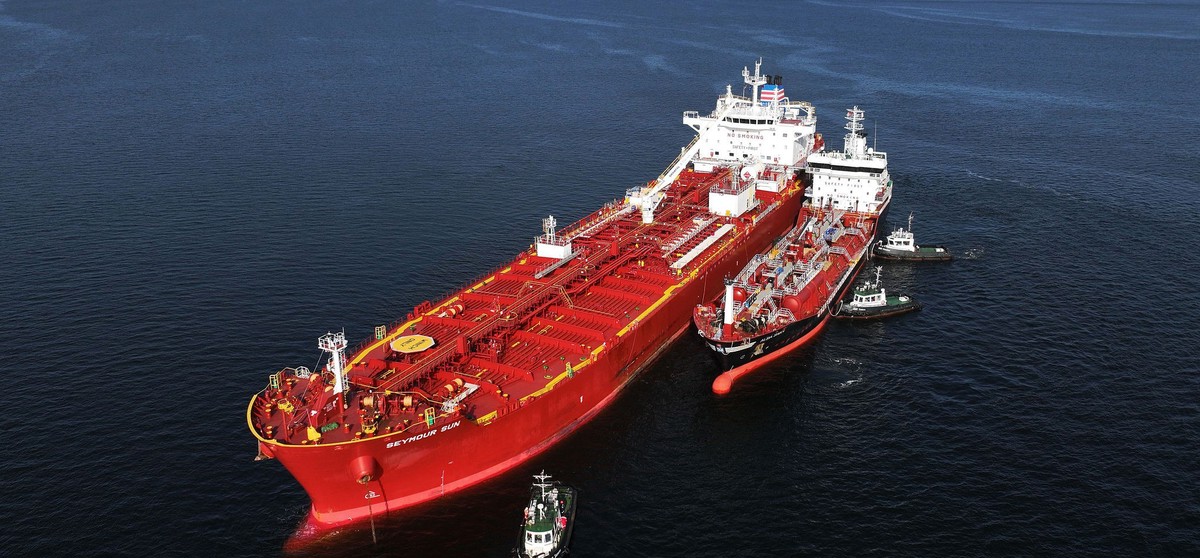INTERVIEW: Dual-fuel orders rising, but offtakes matter more – Methanex
Alternative fuel producers are unlikely to commit to large-scale investments without regulatory support, fuel production incentives and long-term purchase agreements, Methanex’ Denisse Abudinén told ENGINE.
 PHOTO: Uni-Tanker-operated Alsia Swan conducting a ship-to-ship methanol bunkering of the Seymour Sun. Methanex
PHOTO: Uni-Tanker-operated Alsia Swan conducting a ship-to-ship methanol bunkering of the Seymour Sun. Methanex
The IMO has set a goal for the shipping sector to include at least 5-10% zero- and near-zero emission fuels in its bunker fuel mix by 2030. These fuels will include the cleaner variants of methanol, such as bio- and e-methanol.
There are 43 methanol-capable ships in operation today, with another 313 on order for delivery by 2029, according to classification society DNV.
For comparison, the numbers for ammonia are much lower, with only two ammonia-capable ships currently in operation and 25 more on order for delivery by 2027.
“While the number of vessel orders alone doesn’t fully capture the market's readiness to adopt alternative fuels, they do provide a signal of the industry's intent to transition away from conventional fuels,” Denisse Abudinén told ENGINE.
But even if vessel orders are rising, Abudinén says that unless there is regulatory support, incentives for alternative fuels and long-term purchase agreements, fuel producers are hesitant to commit to large investments.
Abudinén serves as the vice president of global low-carbon market at Methanex. The company operates methanol plants across the US, New Zealand, Trinidad and Tobago, Chile, Egypt and Canada. It supplies methanol for bunkering and other industries.
Methanex' shipping arm Waterfront Shipping has a fleet of 19 dual-fuel vessels capable of running on methanol. They make up 60% of Waterfront's fleet and have sailed more than 200,000 hours on methanol, Waterfront says.
One of these vessels, the chemical tanker Seymour Sun, was bunkered with grey methanol in Trinidad and Tobago's Point Lisas in August. That was the first ship-to-ship methanol bunkering in the Caribbean.
Methanex is the world's biggest methanol producer and recently signed an agreement to acquire Dutch methanol supplier OCI’s Global methanol business. The agreement includes a plant in Beaumont, Texas that can produce 910,000 mt/year of methanol and 340,000 mt/year of ammonia, as well as green methanol producer OCI HyFuels.
“Increased orders can boost confidence in fuel producers to invest in supply infrastructure, knowing there's a commitment from the shipping sector to utilize cleaner options. However, given the dual-fuel nature of these vessels, actual demand will depend on many factors and sales contracts will ultimately be required to underpin the necessary investment in low-carbon fuels,” Abudinén said.
“While shipowners can share detailed roadmaps, including timelines for fleet transitions, signing contracts is the most important signal,” she added.
Pilots as proof of concept
Abudinén also highlighted the importance of pilot projects in promoting the use of alternative fuels. These projects provide “tangible evidence” to regulatory bodies and the broader market that alternative fuels like methanol and ammonia are viable options for the shipping industry, which can expedite regulations and scaling up the supply infrastructure.
“Successful pilot projects can build confidence among stakeholders and create momentum for broader adoption,” Abudinén told ENGINE.
“These serve as practical demonstrations of feasibility, safety and training of the ship’s crew/relevant personnel, as well as performance in real-world conditions, providing valuable insights that can help refine technologies and operational practices/guidelines.”
By Konica Bhatt
Please get in touch with comments or additional info to news@engine.online





